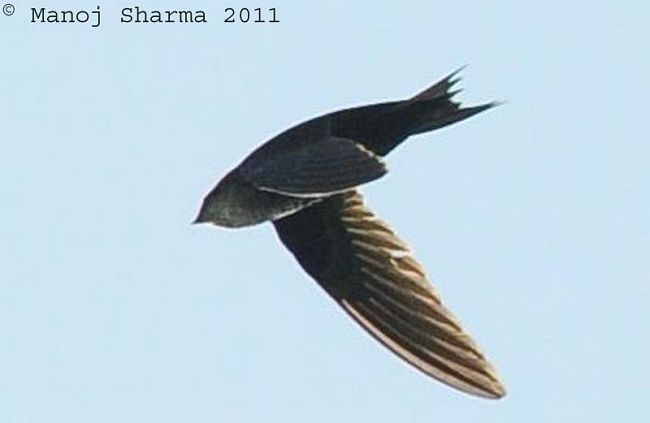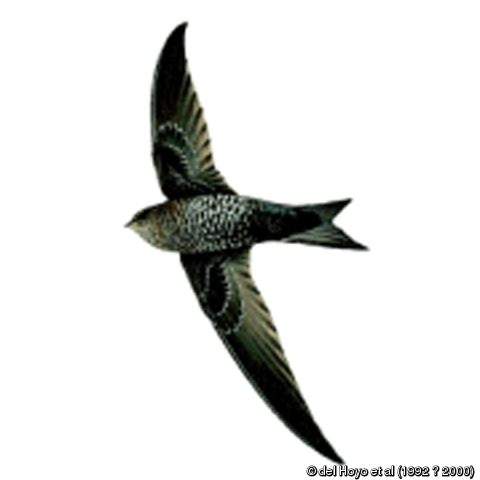| Citation |
|
Description |
Geographic Range [top]
Range Description: Apus acuticauda is known from just a few breeding colonies in the Himalayan foothills in Bhutan, and the hills of Meghalaya, Nagaland and Mizoram, north-eastern India (BirdLife International 2001, Chantler 2005, Ahmed et al. 2007, K. D. Bishop in litt. 2013, J. Eaton in litt. 2013, M. Sharma in litt. 2013). Its seasonal movements and wintering areas are virtually unknown. There are records throughout the year from India and during the non-breeding season from north-western Thailand and Yunnan, China (J. Hornskov in litt. 2005). There are unconfirmed reports of the species from Myanmar (per J. W. Duckworth in litt. 2013). At known breeding colonies, the number of birds ranges from a few to more than 250 (C. Robson in litt. 2013), and the total population may not exceed 1,000 individuals.
Countries occurrence:
Native:
Bhutan; India; Thailand
Vagrant:
Nepal; Sri Lanka
Additional data:
? Continuing decline in area of occupancy (AOO): Unknown
? Extreme fluctuations in area of occupancy (AOO): No ? Estimated extent of occurrence (EOO) - km2: 6500
? Continuing decline in extent of occurrence (EOO): Unknown ? Extreme fluctuations in extent of occurrence (EOO): No
? Number of Locations: 2-5 ? Continuing decline in number of locations: Unknown
? Extreme fluctuations in the number of locations: No ? Lower elevation limit (metres): 200
? Upper elevation limit (metres): 2470
Range Map: Click here to open the map viewer and explore range.
Population [top]
Population: The population is thought to lie within the range 250-999 individuals, based on estimates of breeding colony sizes ranging from a few to 200 individuals. This estimate roughly equates to 167-666 mature individuals, but the population is probably unlikely to be at the lowest end of this range. A provisional population estimate of 250-700 mature individuals is therefore given.
Trend Justification: The population is suspected to be stable in the absence of evidence for any declines or substantial threats. This is supported by observations: records at its known sites have remained stable for many years, for example at Cherrapunji (J. Eaton in litt. 2013).
Current Population Trend: Stable
Additional data:
? Number of mature individuals: 250-700 ? Continuing decline of mature individuals: Unknown
? Extreme fluctuations: No ? Population severely fragmented: No
? No. of subpopulations: 2-100 ? Continuing decline in subpopulations: Unknown
? Extreme fluctuations in subpopulations: No ? All individuals in one subpopulation: No
Habitat and Ecology [top]
Habitat and Ecology: It breeds colonially in the crevices of rocky cliffs and deep gorges, at 200-1,350 m, generally in the vicinity of forest. Breeding is from March to May usually at the same site each year. Birds apparently remain in close proximity to the nesting colonies while breeding, normally disappearing soon afterwards and reappearing the following year. Away from breeding sites, it has been recorded up to at least 1,500 m. It has been suggested that it may only undertake local movements, but this requires further investigation.
Systems: Terrestrial
Continuing decline in area, extent and/or quality of habitat: Unknown
Generation Length (years): 12.5
Movement patterns: Full Migrant
Threats [top]
Major Threat(s): There are no known threats, although its reliance on forest as a feeding habitat should be investigated.
Conservation Actions [top]
Conservation Actions: Conservation Actions Underway
A presumed breeding site is located within the Blue Mountain National Park, Mizoram, north-eastern India. Strict forest policy and wildlife protection laws in Bhutan suggest that its future there is secure.
Conservation Actions Proposed
Encourage surveys for this species across north-eastern India, Bhutan, northern and western Myanmar, Thailand, Laos, Vietnam and Cambodia to establish its breeding range and population status. Research its ecology and seasonal movements. Investigate potential threats. Afford strict protection to all known colonies.
Errata [top]
Errata reason: This errata version of the 2016 assessment was created because the previous amended version of this assessment (published in 2017 to include edits to population estimate and population justification text) was missing the Red List Criteria. The assessment criteria are now added here.
Citation: BirdLife International. 2017. Apus acuticauda (errata version published in 2018). The IUCN Red List of Threatened Species 2017: e.T22686853A123787702. http://dx.doi.org/10.2305/IUCN.UK.2017-3.RLTS.T22686853A117600944.en. Downloaded on 16 November 2018.
Disclaimer: To make use of this information, please check the .
Feedback: If you see any errors or have any questions or suggestions on what is shown on this page, please provide us with feedback so that we can correct or extend the information provided
|


